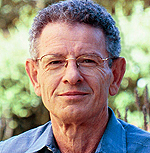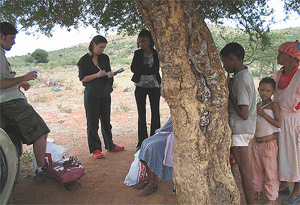March 14, 2011 - By Sandeep Ravindran

Marcus Feldman
The largest analysis of the genomic diversity of African hunter-gatherer populations reveals that modern humans likely originated in southern Africa, rather than eastern Africa as is generally assumed. This study provides the clearest idea yet of where modern humans originated.
About 60,000 years ago, modern humans left Africa and began the spread to other regions of the world. But the great genetic diversity of African populations made it hard to accurately predict where in Africa humans might have originated.
Now, a team led by postdoctoral scholar in genetics Brenna Henn, PhD, and biology professor Marcus Feldman, PhD, has found that modern humans likely originated in southern Africa. To reach this conclusion, the researchers analyzed the largest dataset to date for hunter-gatherer populations. The study was published online March 7 in the Proceedings of the National Academy of Sciences.
“Our belief used to be that the center of humans leaving Africa was in east Africa. This paper focuses attention on southern Africa, and in particular a group of hunter-gatherers, the Bushmen, who speak one of the Khoisan languages,” said Feldman. These languages are characterized by the presence of “click” sounds.
Africa has been inferred to be the continent of origin for all modern human populations, with the earliest modern-human skulls having been discovered in east Africa. In addition, populations outside Africa contain a subset of the genetic diversity found there. As modern humans moved eastward, the level of variation decreased, reaching its minimum in the Americas. But the details of genetic evolution within Africa have remained hazy.
This is mainly because African populations are some of the most genetically diverse in the world. A lack of sufficient genetic samples, especially from the hunter-gatherer populations, made it hard to infer much about early human evolutionary history. “We’ve just never had enough people represented in our studies before,” Feldman said. “Without the participation of these people, patterns of evolution within Africa can’t be determined,” he said.

Researchers Brenna Henn, center, and Christopher Gignoux collecting genetic samples for the study in a Khomani Bushmen community.
The current study provides “a much more satisfying answer,” said Feldman. “We just didn’t have as much DNA data earlier,” he said. Before this study, only a handful of Namibian Khoisan-speakers had been compared with other Africans. To get an accurate picture, the researchers needed to compare the genetics of different hunter-gatherer populations, as well as individuals within each population, at hundreds of thousands of sites in the DNA. According to Feldman, the researchers needed the participation of more Bushmen, and Henn, the paper’s first author, accomplished this.
The scientists analyzed variations in the individual nucleotide bases that make up DNA. They genotyped 650,000 such individual changes or “single-nucleotide polymorphisms” in people from 25 African populations. Apart from the click-speaking hunter-gatherer populations from South Africa and Tanzania, they also studied Pygmies and 21 agriculturalist populations. Statistical analysis showed that the Bushmen had the greatest genetic variation and are most likely to be the source population from which all other African populations diverged.
Different genetic variants contain different combinations of genes, which can be thought of as a single string. Genetic recombination breaks these strings into smaller segments. The older the population, the shorter the segments and the greater the genetic variation.
It was already known that the most variation and hence shortest segments occurred in Africa. The new study found that within Africa, the Bushmen have the shortest segments, and segment length increases as one moves from south to north.
More than 5,000 years ago, sub-Saharan Africa was populated mainly by linguistically and culturally diverse hunter-gatherer populations. Since then, most of these populations have either gone extinct or turned to agriculture and pastoral living, leaving only the Pygmies in central Africa, a click-speaking tribe of Tanzania, the Hadza, and southern African Bushmen, as the last hunter-gatherers.
“The paper is also fascinating in that some hunter-gatherer groups have never mixed with their neighbors,” said Feldman. “The mystery is whether there ever was a connection between the different click-speaking peoples in the past. Brenna and the team have shown that if such a connection ever existed, it was long before the invention of agriculture.”
As evidence of the uniqueness of some of these populations, the researchers found that certain immune system proteins that appear almost nowhere else on Earth occurred at a higher frequency in one hunter-gatherer group. The scientists also found signs of natural selection related to genes involved in immune response and protection against pathogens.
Henn and Julie Granka, a graduate student in biology, recently revisited the South African Bushmen who participated in the study and took height and skin color measurements from the people whose DNA they had analyzed. “We will be collaborating with several South African scholars to look at such phenotypes in more detail,” Feldman said.
According to Feldman, despite large ongoing projects researchers still don’t know enough about human variation. “Not enough populations around the world have been studied,” he said. For example, “We don’t know much about Australian Aboriginals, indigenous Americans or South Asian people, who comprise nearly a sixth of the world’s population,” he said.
Feldman and other researchers working with the Human Genome Diversity Project, based at Centre d’Étude du Polymorphisme Humain in Paris, hope to engage other populations in the search for their evolutionary ancestry. “There are lots of evolutionary problems to be solved,” he said. “Analysis of DNA is our best chance to solve them.”
Genetics professor Carlos Bustamante, PhD, and postdoctoral scholar Jeffrey Kidd, PhD, are co-authors on the study, funded by the Center for Human Origins and Evolution, the Morrison Institute for Population and Resource Studies at Stanford, a UCSF Chancellor’s Graduate Research Fellowship and the National Institutes of Health.
Sandeep Ravindran is a science-writing intern at the Stanford News Service.
About Stanford Medicine
Stanford Medicine is an integrated academic health system comprising the Stanford School of Medicine and adult and pediatric health care delivery systems. Together, they harness the full potential of biomedicine through collaborative research, education and clinical care for patients. For more information, please visit med.stanford.edu.